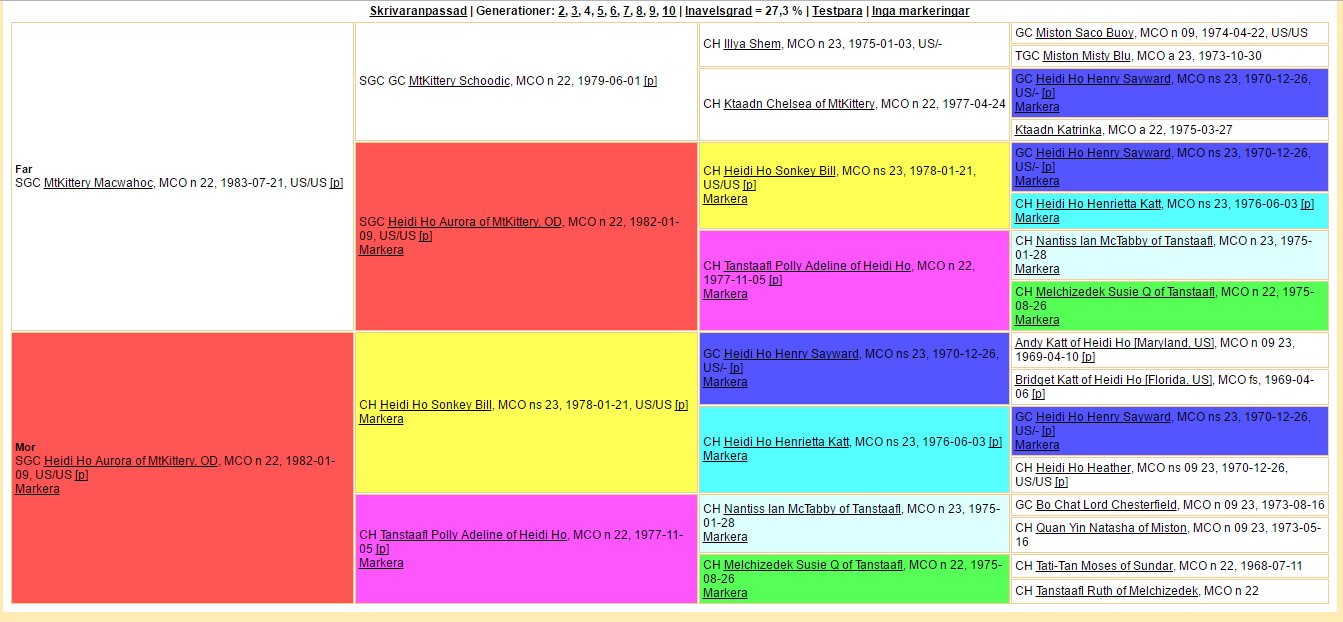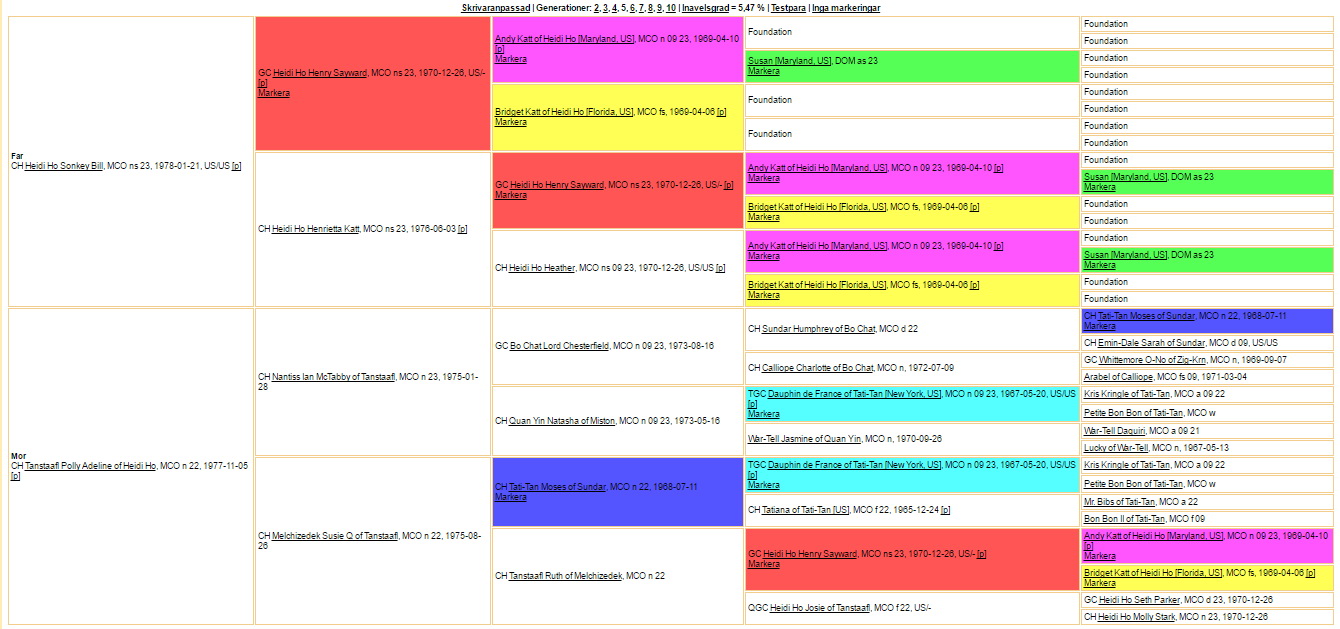I will try to explain the clones, in a simple way, what they are and how they affect our breeding. In order to really understand, please read about"Foundation" first.
In 1978, a cat named Heidi Ho Sonkey Bill, was born, he was both son and a double grandson to Andy and Bridget Katt of Heidi Ho. His father was the son of these two and his mother's two parents were also offspring of these two, the inbreeding in on Sonkey Bill in 4 generations was 37,5%. Below is his pedigree with color markings for all the doubled cats.

When he was mated with Tanstaafl Polly Adeline, their offspring were unbelievable alike. They were all looking almost the same, almost as if they were cloned...
If you think twice, this might not be such a surprise, their genetics were very, very tight. So, how did the nickname clones arose? Below is the explanation in Beth Hicks (Tanstaafl) own words:
The term "clone" was given to the cats from that breeding in April 1982. There was a big TlCA show in New York. Lynne and I were there along with Bunty Washburn, Carol Pedley, Mary Buckmaster, and lots of other Maine Coon breeders. Both Molly Brown (a brown tabby) and Mary's Heidi Ho Lady Arwin (a silver mack tabby) became Supreme Grand Champions at that show. We were all together in a hotel room that evening when we called Connie to give her the news. While Connie was on the phone, somebody said, "Tell Connie we know she is just cloning these cats and painting them different colors"!
Here is the link to the interview with Beth Hicks.
So when we talk about the clones today, we talk about the sons and daughters of Sonkey and Polly. Below you can see their pedigree:

The clones were used over and over again since their offspring became cats of very high show quality and a really good size.
Many breeders decided that a little was good but much was even better!
Even though the clones themselves did not have a very high inbreed (9.4%), there were a lot of linebreeding with them and their offsprings.
Today, many Maine Coon pedigrees have 35% in clones, sometimes up to 50% clones. If you do analyze pedigrees on today's Maine Coon, you will find out that, this is the *special* couple that is so common in our pedigrees. You will also if you start looking to find out that to find a cat ”that is not a new foundation” who has less then 20-25% in clones is impossible not even by looing all over the world, this is kind of scary I think. Just about 10-15 years ago you could still find rare examples of cats with pedigrees having almost no clones behind.
The clones include:
* Heidi Ho Annabel Lee of Tycoon
* Heidi Ho Aurora of MtKittery
* Heidi Ho Barnaby Katt
* Heidi Ho Camille of Calicoon
* Heidi Ho Canth of Tanstaafl
* Heidi Ho Coon Victoria
* Heidi Ho Just Plain Bill Katt
* Heidi Ho Justin Morgan Katt
* Heidi Ho Lady Arwen of Mary B
* Heidi Ho Lovey Mero of Meunerie
* Heidi Ho Molly Brown of Tanstaafl
* Heidi Ho Percival of Meunerie
* Heidi Ho Portius of Olde Farm
* Heidi Ho Rachel Adeline
* Heidi Ho Richard III of Charmalot
* Heidi Ho Sasquatch of Ktaadn
* Heidi Ho Wilyum of Ktaadn
More detailed information about these cats is available in the Maine Coon database.
There are also listed additional offspring from varying other matings of the top five cats.
Well, now we need to try thinking in percentages.
If you imagine that your cat's pedigree is made up of 100 cats = 100%.
If then let's say your cat had 50% clones in the pedigree, this should be 50 cats, right?
This means half of all the cats in your cat's pedigree are derived from the same siblings!
If instead, let's say your cat had 25% in clones, this means, 25 of the 100 cats are clones.
Then, a quarter of your cat's pedigree consists of these 17 siblings in this case!
If a number should be mentioned as an ok value, it should be somewhere around 10% in clones, that's a number, not even the experienced outcross breeders manage to keep more then on a few cats because of the lack of New Foundation and really low cloned cats.
I often hear statement like "OMG! This was over 30 years ago!" It does not affect our cats today?
Well, it’s exactly what it does, no matter how we wish to ”put our heads in the sand” and shut it out, we can't deny, that this is a huge genetic bottleneck we are dealing with on our Maine Coons and we have to work with it, we have to work together for our breed and reduce the value on the clones overall. Not everyone needs to work with new foundation, but everyone can keep track of the values and lower them slowly bit by bit.
I usually make a parable with a dough (the dough = all Maine coons). We seasoned the dough with a little bit of salt (the clones) to give it that little extra touch. A little bit salt turned out to be really tasty, so we added a bit more salt. In the end, the dough became quite salty, which meant 30-35% salt. No matter how much we bump and knead this, how many parts we share it in and then merge with each other again, it will always be too salty, right? Even 30 years later. In order to reduce the salt we need to add something else that has no salt in it, for the Maine coon breed this means new foundation or cats that are unrelated to the clones.
By: Malin Sundqvist
Dagdrivarn (www.dagdrivarn.se)










